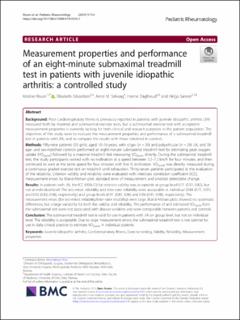| dc.contributor.author | Risum, Kristine | |
| dc.contributor.author | Edvardsen, Elisabeth | |
| dc.contributor.author | Selvaag, Anne Marit G | |
| dc.contributor.author | Dagfinrud, Hanne | |
| dc.contributor.author | Sanner, Helga | |
| dc.date.accessioned | 2020-04-29T09:32:20Z | |
| dc.date.available | 2020-04-29T09:32:20Z | |
| dc.date.created | 2019-06-28T11:05:16Z | |
| dc.date.issued | 2019 | |
| dc.identifier.citation | Pediatric Rheumatology. 2019, 17, 14. | en_US |
| dc.identifier.issn | 1546-0096 | |
| dc.identifier.uri | https://hdl.handle.net/11250/2652893 | |
| dc.description | This article is distributed under the terms of the Creative Commons Attribution 4.0 International License (http://creativecommons.org/licenses/by/4.0/), which permits unrestricted use, distribution, and reproduction in any medium, provided you give appropriate credit to the original author(s) and the source, provide a link to the Creative Commons license, and indicate if changes were made. The Creative Commons Public Domain Dedication waiver (http://creativecommons.org/publicdomain/zero/1.0/) applies to the data made available in this article, unless otherwise stated. | en_US |
| dc.description.abstract | Background: Poor cardiorespiratory fitness is previously reported in patients with juvenile idiopathic arthritis (JIA) measured both by maximal and submaximal exercise tests, but a submaximal exercise test with acceptable measurement properties is currently lacking for both clinical and research purposes in this patient population. The objectives of this study were to evaluate the measurement properties and performance of a submaximal treadmill test in patients with JIA, and to compare the results with those obtained in controls.
Methods: Fifty-nine patients (50 girls), aged 10–16 years, with oligo- (n = 30) and polyarticular (n = 29) JIA, and 59 age- and sex-matched controls performed an eight-minute submaximal treadmill test for estimating peak oxygen uptake (VO2peak) followed by a maximal treadmill test measuring VO2peak directly. During the submaximal treadmill test, the study participants walked with no inclination at a speed between 3.2–7.2 km/h for four minutes, and then continued to walk at the same speed for four minutes with five % inclination. VO2peak was directly measured during a continuous graded exercise test on treadmill until exhaustion. Thirty-seven patients participated in the evaluation of the reliability. Criterion validity and reliability were evaluated with interclass correlation coefficient (ICC); measurement errors by Bland-Altman plot, standard error of measurement and smallest detectable change.
Results: In patients with JIA, the ICC (95% CI) for criterion validity was acceptable at group level 0.71 (0.51, 0.82), but not at individual level. The test-retest reliability and inter-rater reliability were acceptable at individual (0.84 (0.71, 0.91) and 0.92 (0.83, 0.96), respectively) and group levels (0.91 (0.83, 0.96) and 0.96 (0.91, 0.98), respectively). The measurement errors (for test-retest reliability/inter-rater reliability) were large. Bland-Altman plots showed no systematic differences, but a large variability for both the validity and reliability. The performance of and estimated VO2peak from the submaximal test were not associated with disease variables and were comparable between patients and controls.
Conclusion: The submaximal treadmill test is valid for use in patients with JIA on group level, but not on individual level. The reliability is acceptable. Due to large measurement errors, the submaximal treadmill test is not optimal for use in daily clinical practice to estimate VO2peak in individual patients. | en_US |
| dc.language.iso | eng | en_US |
| dc.subject | juvenile idiopathic arthritis | en_US |
| dc.subject | cardiorespiratory fitness | en_US |
| dc.subject | exercise testing | en_US |
| dc.subject | validity | en_US |
| dc.subject | reliability | en_US |
| dc.subject | measurement properties | en_US |
| dc.title | Measurement properties and performance of an eight-minute submaximal treadmill test in patients with juvenile idiopathic arthritis: A controlled study | en_US |
| dc.type | Peer reviewed | en_US |
| dc.type | Journal article | en_US |
| dc.description.version | publishedVersion | en_US |
| dc.rights.holder | © The Author(s). 2019 | en_US |
| dc.source.pagenumber | 10 | en_US |
| dc.source.volume | 17 | en_US |
| dc.source.journal | Pediatric Rheumatology | en_US |
| dc.identifier.doi | 10.1186/s12969-019-0316-7 | |
| dc.identifier.cristin | 1708561 | |
| dc.description.localcode | Seksjon for fysisk prestasjonsevne / Department of Physical Performance | en_US |
| cristin.unitcode | 150,31,0,0 | |
| cristin.unitname | Seksjon for fysisk prestasjonsevne | |
| cristin.ispublished | true | |
| cristin.fulltext | original | |
| cristin.qualitycode | 1 | |
